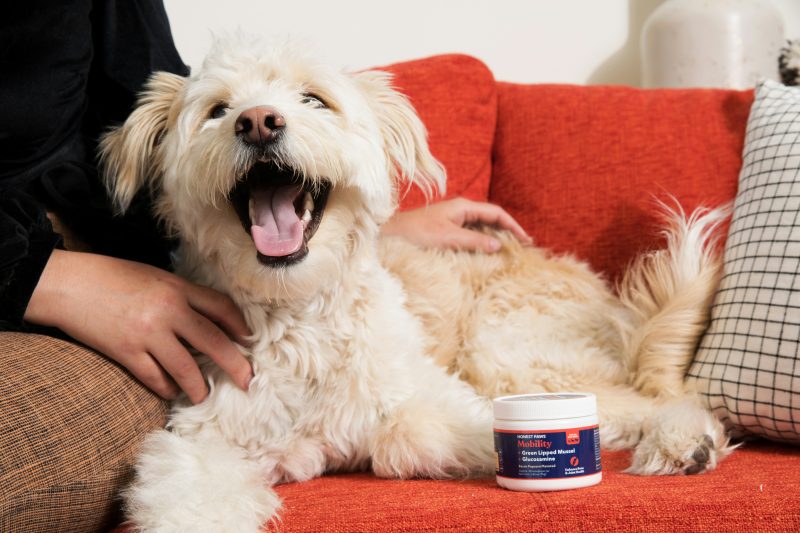
High-Strength Joint Supplements for Dogs
You want the best for your furry friend – those tail wags and playful zooms are what make your day. But as your pup gets older, you may notice them slowing down. Stiffness in their joints makes it harder for them to jump up on the couch or go on long walks. Just like humans, dogs can face chronic joint issues as they age. You’ve probably heard of common problems like arthritis and hip dysplasia. Fortunately, there are steps you can take to support your aging pup’s joint health. High-strength joint supplements are one option to consider adding to their regimen.
These over-the-counter blends use key ingredients to nourish joints and keep your dog comfortable. As you shop around, you’ll find a variety of products making all kinds of claims. How do you know what to look for? What ingredients really make a difference? You want to pick the right match for your dog based on their size, breed, and specific needs.
This guide will walk you through the key considerations for choosing and incorporating a joint supplement. You’ll learn about common joint problems in dogs, what to look for on the ingredient list, how to select the right product, and lifestyle changes that can further support your dog’s joints. Let’s dig in!
Common Joint Issues in Dogs
Before diving into supplements, it helps to understand some background on joint problems in dogs. Some of the most prevalent conditions include:
Arthritis
Just like in humans, arthritis is inflammation in one or more joints. It develops over time as cartilage breaks down. Signs include limping, trouble standing up or lying down, decreased activity levels, and yelping in pain. Arthritis often stems from abnormal wear on the joints over the years. Larger breeds and senior dogs are most susceptible.
Hip Dysplasia
This common developmental disorder stems from improper formation of the hip socket. Instead of snugly holding the femoral head, the socket is too shallow, allowing excessive movement and joint instability. Over time, arthritis develops. Signs include bunny hopping, swaying hindquarters, reluctance to go upstairs, and limping. Treatment ranges from weight management to surgery for severe cases.
Elbow Dysplasia
Similar to hip dysplasia, elbow dysplasia refers to abnormal development of the elbow joint, resulting in a loose, unstable fit between the bones. Arthritis and lameness eventually occur. Dogs may resist lying down, seem stiff getting up, or cry out in pain. Managing weight, anti-inflammatories, rehabilitation therapy, and surgery are treatment options.
Cranial Cruciate Ligament Tears
The cranial cruciate ligament stabilizes the knee (stifle) joint. When torn, either from injury or gradual degeneration, the joint becomes unstable. A partial or complete rupture results in inflammation, swelling, and eventually, arthritis. Dogs show sudden lameness, holding the leg up. Surgery to stabilize the joint may be recommended.
Intervertebral Disc Disease
While not a classic joint issue per se, slipped discs put pressure on the spinal cord and nerve roots, causing neurologic signs and pain. Discs tend to degenerate with age or can herniate after trauma. Signs involve weakness, unsteadiness, and pain in the limbs or neck. Mild cases may respond to rest and medication, while severe herniations may require decompression surgery.
Risk Factors
Certain dogs are at increased risk for joint issues, either due to breed, size, or lifestyle factors:
- Larger breeds: Heavier dogs, like Labradors, are more prone to hip and elbow dysplasia, cruciate tears, and disc disease. The joints, ligaments, and discs face greater stress.
- Smaller breeds: Younger, smaller dogs can suffer patellar luxation, where the kneecap pops out of position. Breeds like Yorkies are predisposed.
- Athletic dogs: Hunting dogs and other active breeds with slim builds, like Greyhounds, may overwork their joints through field trials, racing, or high-energy play.
- Overweight: Excess pounds strain the joints tremendously. Obese dogs show earlier, more severe arthritis than leaner pups. Weight loss helps!
- Prior injury: Damage to joints, especially at a young age, raises the risk of osteoarthritis later on. Once a joint becomes arthritic, more injury can occur. It’s a vicious cycle.
- Genetics: For hip dysplasia, elbow dysplasia, and disc disease, inherited factors play a role. Careful screening by responsible breeders helps reduce affected puppies.
Easing Existing Joint Problems
If your dog already has arthritis or an orthopedic condition, don’t fret – there are many ways to improve their comfort and mobility. Work closely with your veterinarian to find the right combination of therapies for your pup. Options include:
- Weight management: Helping your dog slim down takes pressure off sore joints. It offers one of the biggest quality of life improvements.
- Pain medication: Nonsteroidal anti-inflammatories (NSAIDs), steroids, and newer pain drugs greatly relieve arthritis discomfort.
- Disease-modifying osteoarthritis drugs (DMOADs): These medications may help stabilize cartilage breakdown and improve joint health.
- Rehabilitation therapy: Physical therapy exercises improve strength, balance, and joint mobility. Therapists also use modalities like heat, cold, laser, ultrasound, and underwater treadmills.
- Assistive devices: Braces, harnesses, ramps, and orthopedic beds provide extra support and take pressure off tender joints.
- Alternative therapy: Acupuncture, therapeutic massage, chiropractic care, and nutraceutical supplements also help some dogs.
- Surgery: For traumatic knee and shoulder injuries, slipped discs, or severe hip dysplasia, surgery can provide lasting relief when conservative options fail.
Ingredients to Look for in Joint Supplements
When comparing products, the ingredient list provides key insights on quality and effectiveness. Familiarize yourself with these compounds that have research supporting their joint benefits:
Glucosamine
One of the most popular and well-studied joint supplement ingredients, glucosamine is a natural compound found in cartilage and fluid around the joints. Oral supplements help repair and build cartilage while reducing inflammation. Look for the hydrochloride form for better absorption.
Chondroitin
This cartilage-building block is often coupled with glucosamine. It attracts fluid into the cartilage for shock absorption. Chondroitin also inhibits enzymes that break down cartilage. It’s best absorbed in the sulfate form.
Omega-3 Fatty Acids
You’ll often see blends with fish oil or other omega-3 sources. These healthy fats reduce inflammation, promote joint lubrication, and may slow cartilage breakdown.
MSM
Methylsulfonylmethane (MSM) contains sulfur, an important component of joints. It’s thought to support collagen in ligaments and tendons. MSM may also have anti-inflammatory effects.
Green-Lipped Mussel
This mollusk extract contains unique omega-3s that inhibit inflammatory compounds. Some research shows it outperforms NSAIDs for arthritis.
When scanning labels, you want to see therapeutic doses of one or more of these key nutrients. A reputable brand will share specific milligram amounts rather than just listing ingredients. Let’s move on to tailoring your selection for your pup!
Choosing the Right Supplement
With all the options on the market, how do you narrow it down? Consider these three factors:
Your Dog’s Size
Dosing is typically based on weight, so choose a product formulated for your pup’s size category:
- Small/toy breeds up to 20 lbs
- Medium breeds 20-50 lbs
- Large/giant breeds over 50+ lbs
The label should provide a dosage chart or specific dose for your dog’s weight. This ensures proper concentration of the active ingredients.
Your Dog’s Breed
Some breeds have a higher predisposition for joint issues. For example, hip and elbow dysplasia are common in German Shepherds and Labrador Retrievers. Great Danes and St. Bernards often develop arthritis due to their massive size.
Select products tailored to your dog’s expected joint needs. For at-risk breeds, look for advanced strength options clearly labeled for joint “support” rather than just “maintenance.”
Your Dog’s Joint Health History
If your pup has already been diagnosed with arthritis, cruciate injuries, or other joint conditions, discuss supplement options with your vet. They may recommend prescription-strength products not available over the counter in human stores.
Your vet can also advise if specific ingredients like glucosamine or omega-3s make the most sense based on your dog’s needs.
Getting the right match sets your dog up for better results as you add it to their regimen.
Combining Supplements with Veterinary Care
While supplements can make a significant difference, they should complement (not replace) veterinary care. Before starting any new supplement, talk to your vet, especially if your dog has:
- Diagnosed joint conditions
- Other health issues
- Taken NSAID pain medications
Some supplements can interact with medications. Your vet needs the full picture to ensure safety.
Schedule regular veterinary checkups to monitor your dog’s joint health and mobility even once on supplements. Your vet may recommend x-rays over time to check cartilage and joint changes. They can also suggest prescription products if an over-the-counter option isn’t providing enough relief.
Think of supplements as one piece of a joint care plan supervised by your trusted vet.
Lifestyle Adjustments for Dogs with Joint Issues
In addition to supplements and vet care, a few changes at home can take pressure off your dog’s joints:
Weight Watchers…for Dogs
Here’s a bit of tough love: Is your pup packing on a few extra pounds? Some chunky fur babies try to pull at your heart strings for more treats. But all that weight puts major strain on their joints. Helping them slim down even a little can make a huge impact on their mobility and comfort.
You’re gonna need to resist those pleading eyes. Consult your vet on an appropriate diet plan. Measure out their food instead of free feeding. Cut back on table scraps and high calorie treats. And be strong in the face of puppy dog eyes! As cute as they are, your buddy will thank you for the weight loss in the long run.
Ramp It Up
Stairs might be getting tricky for your dog these days. Going up and down puts a lot of repetitive stress on those sore joints. So, save their knees and invest in some doggy ramps! Look for gentle sloped ramps covered in a non-slip surface. That way they can still comfortably access the couch, your vehicle, the bed, wherever their favorite hangout spots are.
Ramps can be pricey, so if it’s not in your budget right now you can also help them navigate stairs. Walk alongside them ready to lend a hand balancing. Or better yet, carry them when you can! Added bonus: you get snuggle time.
Playtime Adjustments
Your energetic pup may not realize they should start slowing down as they age. It’s up to you to enforce some rest time. But don’t deprive them of playtime altogether! Physical activity is important for their joint health too as long as it’s low impact.
Instead of high intensity games of fetch or tug of war, opt for gentler activities. Leisure walks and swimming are great joint-friendly choices. If they love to chase, roll a ball along the ground rather than throwing it. You can also look into senior agility courses with low jumps. Just get creative coming up with more mellow games.
Massage Therapy
Here’s some pampering your pooch will definitely appreciate – massage therapy! Light rub downs stimulate blood flow and loosen tense muscles surrounding painful joints. Your vet can suggest anti-inflammatory gels or oils to use. But even gentle petting helps!
Focus on areas like hips, knees, elbows, shoulders and backs. Always start slow with light pressure, working your way deeper as your dog relaxes. If they seem sore or uncomfortable somewhere, ease up right away. The goal is to bring relief, not cause more pain. A few minutes a day can make a big difference improving flexibility.
Bedding Upgrades
An orthopedic dog bed can take pressure off your pup’s achy joints, letting them rest much more comfortably. Look for thick, supportive memory foam mattresses. They should be dense enough that your finger doesn’t sink in too deep when pressed into the bed. This gives joints cushioning while keeping the spine aligned.
For dogs with hip issues, consider a nest or donut style bed. The raised edges help them easily stand up without stressing sore hips. Older dogs often have bladder control troubles too. Waterproof liners built into the covers make any accidents simple to clean up.
Keep On Keepin’ On
While your dog can’t be as active as they used to be, joint issues don’t have to mean the end of fun times together. You may just need to adapt to their changing physical abilities. Patience and persistence is key! With medication, physical therapy, lifestyle adjustments and lots of TLC, your furry BFF can continue enjoying many more happy, comfortable years by your side.
Conclusion
From ingredient lists to dosing instructions to lifestyle tweaks, choosing and incorporating joint supplements for your dog involves many considerations. But ultimately, the effort pays off in improved comfort, mobility, and quality of life. As your pup slows down in their senior years, you feel reassured knowing you’re doing everything you can to support their joints.
Commit to regular vet checkups, monitor changes in your dog’s movement and behavior, and don’t hesitate to adjust course if one product isn’t giving the results you hoped for. Be patient – it can take weeks or months to notice a difference as ingredients build up in their system. But with the right supplement matched to your dog’s needs, those playful puppy antics can make a comeback!


